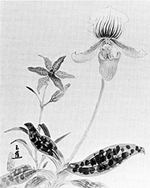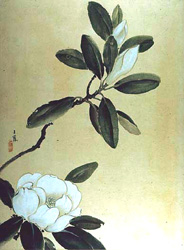John & Katharine Maltwood Collection
| View the Collection |
History of the Collection |
John & Katharine Maltwood |
Information Resources |
Background Maltwoods as Collectors Cultural Context The Arts and Crafts Movement in Victoria
The Collection Museum at "The Thatch" Notable B.C. Artists in the Maltwood Collection - Introduction - Emily Carr - William Percy Weston - Charles John Collings - Ina D.D. Uhthoff - Hildegarde Wyllie - Daisy R. Swayne & Emily Schofield - Elizabeth Duer - Barbara Woodward - Stella Langdale History of the Maltwood Collection (ppt 14.6 MB)
About Us Contact Us Visit Us Site Map

Notable B.C. Artists in the Collection - Elizabeth Duer | ||||
Elizabeth Duer was brought up and educated in the stately atmosphere and ritual of the Japanese Imperial Court. Her English father served as an adviser to the Emperor, while her mother, an amateur painter, was a member of a prominent Japanese family. Elizabeth Duer was honoured by receiving the art name of "Gyokushi" from her famous art teacher Gihoshi Atomi, painter for the Japanese Imperial family.92 In her style Madame Atomi and her pupils followed the School of Shijo-ha which was founded by Maryama Okyo in the eighteenth century. The latter was one of the first to break away from the old method of learning by copying a teacher's work and instead advocated a direct contemplation of nature. Flower, bird and animal studies were a speciality and in the Japanese tradition of humility before nature such works became philosophical and poetic experiences.
After a grounding in Oriental art Elizabeth Duer turned to Western culture, studying oils, pastels, charcoal and watercolour at the Slade in London. Having absorbed a comprehensive curriculum she then returned to her favourite medium of expression, watercolour on silk in the Japanese fashion. At the outbreak of the Second World War, due to their pro-British sympathies, several members of the Duer family were interned in Japan. Elizabeth managed to escape and chose to join her cousin in Victoria. Wild Flowers Around Victoria were ideal subjects for the interpretation of Elizabeth Duer style. They are executed in watercolour on silk and are delicately handled using the single stroke method with soft pure colours. The flowers are usually grouped as they grow together in nature and are elegantly arranged in a single spray or two with utmost care to detail, texture and balance. Works such as "Snowberry, Bramble and Wild Rose" display the artist's subtle sense of colour and decorative design. In their meticulous observation of nature the long series naturally has a documentary character and yet is pervaded by a charming quality of delicate, transient reality.
All content on this page is copyright © 7 February, 2006 |
||||

